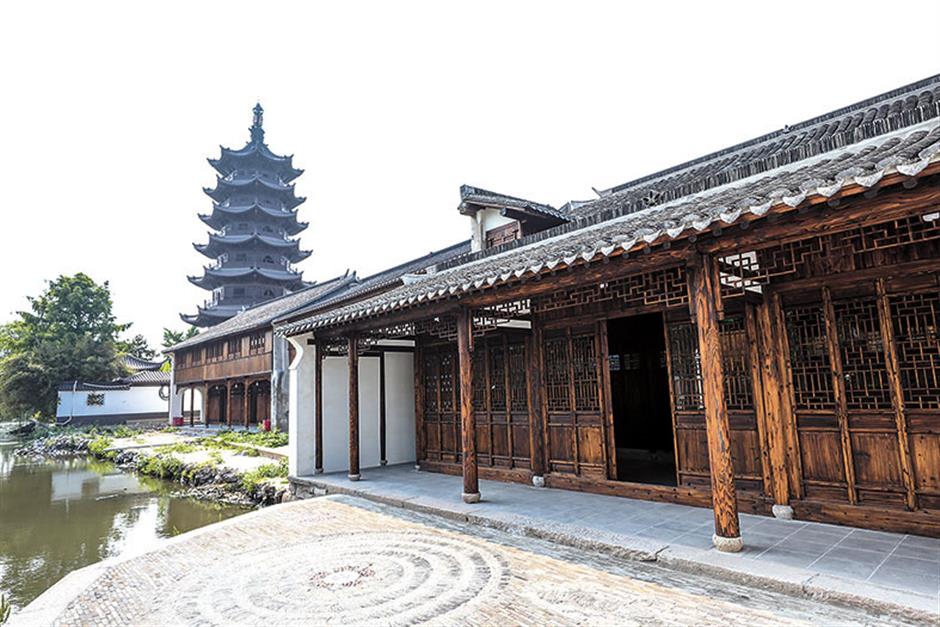A watertown returns to its glorious past

A typical Shanghai stone-gate courtyard house in an alley at Sijing Town. Locals still live in this building but they are waiting to move, as the house will be renovated in the future.
Sijing, a small, thousand-year-old watertown in Songjiang District, plans to remove all the blight of disrepair and crass commercialism, and return the town to its former glory.
A traditional Chinese gate on Kaijiang Road marks the main area of the town. Behind that is a pagoda, a landmark that can be seen from afar.
But other than those nice touches, the main street looks a bit rundown. On one side are lousy-looking grocery shops, with goods piled up on the pedestrian walkway outside.
Many of the buildings on the street have obviously been altered in the past, in a hodge-podge of styles. Illegal structures abound. The original white wall and black tiles that once distinguished the town’s ancient architecture can hardly be seen.
Just beside the pagoda are three traditional stone-gate courtyard houses that have been renovated. Their fine appearances point to the possibilities for the town’s rehabilitation.
The western-most of the houses is the Cheng family dwelling, first built in the Ming Dynasty (1368-1644). The other two, the homes of the Sun and Guan families, were built in the Qing Dynasty (1644-1911). The names reflect the current owners, not the original families.

Fulian Bridge, the last stone bridge remaining in the watertown. It was rebuilt in 1986, the original bridge was damaged during war time and later demolished.
The outer walls of the three buildings are connected, and each building has an imposing wooden door.
“They were just crack houses, like the ones across the street, when the renovation began,” said Wang Jin, an architect from Bright Life Property who leads the facelift project.
It took Wang and his team a year to refurbish the buildings. Cheng’s house preserves the original interior decor, including a black carved ceiling beam in the parlor that includes hooks where lanterns once hung. The beam blackened when part of the parlor was converted to kitchen use.
Wang said there were formerly more than 40 families living in the three buildings, and none of them was from the original family. They didn’t bother about maintenance and added illegal structures. They were eager to move out when work began, Wang said.
During the restoration, workers found a stone tablet buried under a room of Sun’s home.
“We realized the room was an illegal structure built at the boundary of the two buildings,” Wang said. “It used to be a yard.”
Lack of historical materials made it more difficult to restore the buildings as they once were. The team could only guess the age and structural details of the original buildings from scant decor that remained.

A distant view of three renovated historical buildings in Sijing Town.
Difference in the details
All decor, from beams to patterns on doors and windows, were restored by craftsman Chen Shenglin from Zhejiang Province.
“Machine-made materials are more efficient, but then everything looks the same,” Chen said. “Using my own hands, I can bring out the differences in details.”
Bright Life Property is now ready to restore the back yards of the three houses along the Sijing River, one of four waterways that originally created a flourishing commercial town and gave Sijing its name, which translates as “four rivers.”
“The backyards used to be the front doors of the buildings,” Wang said. “The buildings were used as shops along the river and people traveled by boat.”
A corridor once connected the backyards of the three buildings and stretched out for 1.5 kilometers, but it was blocked a long time ago.
Zhou Zhiguo, 78, who still lives in a riverside house his grandfather built a century ago, said he remembers the bustling market alongside the waterway. He said it reminded him of the famous Chinese painting “Along the River During the Qingming Festival.”

The riverside backyard of Sun’s dwelling.
“Boats sped along the river as fishermen tried to be the first to bring their catches to market,” said Zhou. “I remember the noise of vendors peddling their goods and the laughter of people shopping.”
Many of Zhou’s old neighbors have left. Zhou said he used to rent three rooms of his house to grocers, but they, too, have gone.
“The houses are so old that everyone wants to leave,” said Zhou, adding he is also looking for an apartment in a residential community in new Sijing Town, which is only about 3 kilometers away.
According to Wang, Zhou’s house is among 39 historical structures earmarked by the local government for renovation in the next eight years.
Restoring old buildings to their original look, as much as possible, has become the prevailing concept of such renewal projects. Wang said when he first graduated from college 10 years ago, restoration of historical buildings was all about speed, and many old crafts were lost.
“Some people say why bother when anything built today will become historical in 100 years’ time,” said Wang. “But I think we should try our best to keep history as it was.”
Several months ago, a coffeehouse chain approached Bright Life and expressed an interest in renting one of the restored houses to open a new cafe. But Wang and his team want to turn the three buildings into a small museum showcasing local culture and history.
“Sometimes restoring old buildings is contradictory to commercialization,” Wang said. Renovation on three more buildings located on Kaijiang Road will start in October.















